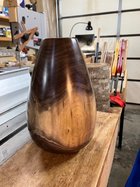After a fair amount of studying and some trial and error I'm now using the Critter siphon feed spray gun and shellac. I've only just started using it but so far I'm pleased with the ease of use, cleanup, minimal overspray, standard jars for finishes, etc. That said, I'm still a novice at spray finishes. I have an HVLP sprayer and a large airless sprayer but painting latex or stain on a barn or fence is not the same thing as getting a nice deep gloss with shellac or lacquer on a large vase.
I'm currently focused on shellac for vases where I want a deep finish. My first test went fairly well but a bit of orange peel (expected for a novice) so looking for some input on anyone using a siphon sprayer and shellac re the cut to use, waxed or dewaxed, etc. I really like shellac finishes when I apply it by hand but on larger vases it would be easier to be able to do a quick spray coat or two and then maybe finish with polishing. I haven't tried it with lacquer yet. I have a small shop so I need days where I have good outside climate and can get good ventilation. Shellac is much more manageable re fumes than lacquer.
I'm currently focused on shellac for vases where I want a deep finish. My first test went fairly well but a bit of orange peel (expected for a novice) so looking for some input on anyone using a siphon sprayer and shellac re the cut to use, waxed or dewaxed, etc. I really like shellac finishes when I apply it by hand but on larger vases it would be easier to be able to do a quick spray coat or two and then maybe finish with polishing. I haven't tried it with lacquer yet. I have a small shop so I need days where I have good outside climate and can get good ventilation. Shellac is much more manageable re fumes than lacquer.


